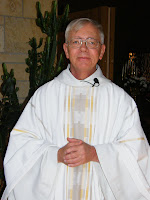
We are beginning a series of homilies to explain some of the recent church teaching on communities of vowed men and women. This all began with Pope John Paul II’s intention in the mid 1990s to encourage and support these communities, which hadn’t received much attention in the post-Vatican II years. In 1994 the World Synod of Bishops dealt with the topic, "The Consecrated Life and its Mission in the Church and the world." Two years later John Paul issued an Apostolic Exhortation on the Consecrated Life. Since then the Vatican Congregation for Institutes of Consecrated Life has continued to issue major documents. These are the background for the upcoming Apostolic Visitation of communities of women in the United States.
One of the first things the Vatican did was drop the phrase, "religious communities," which had been used for centuries. That phrase could give the impression that everyone else in the Church was not religious. That was replaced with "communities of consecrated life." There’s a theological aspect as well to the newer phrase; taking vows of poverty, chastity and obedience becomes an "act of consecration," of consecrating oneself to Christ. And it’s that which John Paul II addressed in his Apostolic Exhortation. As an act of consecration the taking of vows becomes a positive act and not just a renunciation of something, as it was often understood in Church teaching before the Second Vatican Council. It is the choice to live more closely the exact kind of life that Jesus himself lived: obedient, single and poor. The consecration of vows is trying to conform one’s whole life to Christ.
The Holy Father notes that the gospel basis of consecrated life is to be sought in the special relationship which Jesus established with some of his disciples. He called all to welcome the Kingdom of God into their own lives and put their lives at its service; he called some to closely mirror his own way of life. In such a life baptismal consecration develops into a radical response in the following of Christ through acceptance of the evangelical counsels. Perhaps the most strikingly new image is the use that the Holy Father makes of the biblical event of the Transfiguration. There Jesus chooses Peter, James and John from the rest to accompany him up Mount Tabor and to see his radiant transfigured face. Almost all the subsequent Congregation documents pick up and use the image of the Transfiguration.
Through the centuries Christ has continued to call some to this more radical following of him in the consecration of their lives through the vows. The Vatican documents are very concerned that vowed men and women see their vows as a positive act, an act of consecration to a more exact following of Christ. If they do, then their vows become one lens (not the only lens), but one lens that offers a glimpse into the depths of the eternal and infinite love of God, which is the root of our very being.
For these reasons the Pope affirms very strongly that the profession of the evangelical counsels in consecrated life indisputably belongs to the essential life and holiness of the Church. John Paul writes: "Consecrated persons ‘at the deepest level of their being...are caught up in the dynamism of the Church’s life, which is thirsty for the Divine Mystery and called to holiness. It is to that holiness that they bear witness." (Consecrated Life, # 39) That’s beautiful to reflect on!
Monday, September 28, 2009
Fr. Matthias Neuman's Homily for the 26th Sunday in Ordinary Time
Subscribe to:
Post Comments (Atom)




No comments:
Post a Comment